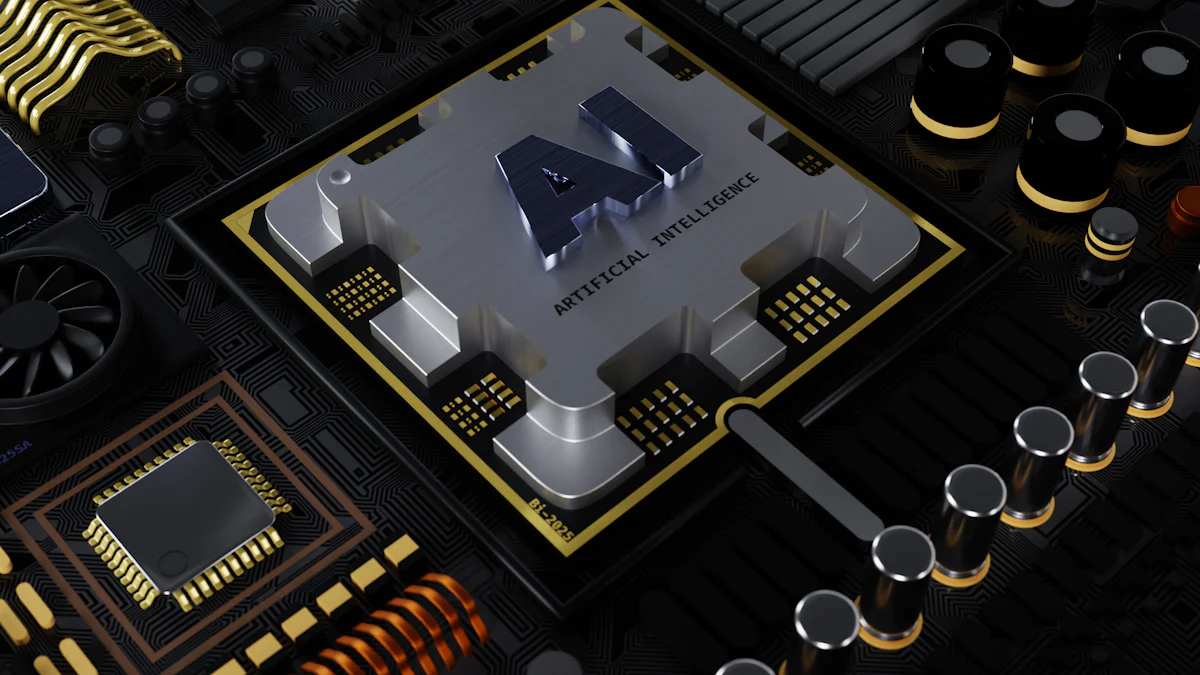The Business Case for Implementing AI Observability

AI observability illuminates the inner workings of AI models, ensuring reliability, security, and transparency. Businesses increasingly rely on AI to drive innovation and efficiency. The average person generates 1.7MB of data per second, highlighting the need for robust monitoring. Companies must adopt AI observability to maximize the value of AI investments. This practice enables organizations to predict and control costs, performance, and data reliability. By investing in AI observability, businesses can optimize performance and ensure the effective operation of AI systems.
Understanding AI Observability
Definition and Scope
What is AI Observability?
AI observability provides insights into the internal workings of AI models. This practice ensures that AI systems operate reliably, securely, and transparently. Businesses use AI observability to monitor AI infrastructure, including large language models (LLMs). The goal is to understand system states by examining outputs.
Key Components of AI Observability
AI observability comprises several key components:
Data Monitoring: Tracks data flow and quality.
Model Performance: Measures accuracy and efficiency.
System Health: Monitors infrastructure stability.
User Interaction: Analyzes user behavior and feedback.
These components work together to provide a comprehensive view of AI systems.
Importance in Modern Business
Ensuring AI Reliability
Businesses must ensure the reliability of AI systems. AI observability helps identify and resolve issues before they impact operations. This proactive approach minimizes downtime and maintains system integrity. Companies can trust their AI models to perform consistently.
Enhancing AI Performance
AI observability enhances performance through real-time monitoring and analytics. Businesses can optimize AI models by identifying bottlenecks and inefficiencies. This leads to improved decision-making and faster response times. Companies gain a competitive edge by maintaining high-performance AI systems.
Mitigating Risks and Failures
AI systems often operate in dynamic environments. AI observability mitigates risks by providing visibility into potential failures. Businesses can address vulnerabilities and ensure compliance with regulations. This reduces the likelihood of costly errors and enhances overall security.
Benefits of Implementing AI Observability

Operational Efficiency
Streamlining AI Operations
AI observability transforms AI operations into streamlined processes. Companies can monitor data flow and model performance in real-time. This capability allows for immediate adjustments to optimize efficiency. Businesses can identify and resolve issues quickly, reducing operational bottlenecks.
Reducing Downtime
AI observability minimizes downtime by providing continuous insights into system health. Real-time monitoring detects potential failures before they escalate. Companies can proactively address vulnerabilities, ensuring uninterrupted operations. This approach enhances overall system reliability and performance.
Improved Decision Making
Data-Driven Insights
AI observability empowers organizations to make informed decisions based on data-driven insights. By analyzing trends and patterns, businesses can predict outcomes and adjust strategies accordingly. This practice leads to more accurate and effective decision-making processes.
Real-Time Analytics
AI observability offers real-time analytics, enabling businesses to respond swiftly to changing conditions. Companies can leverage this capability to gain a competitive edge. Real-time data allows for quick adjustments, ensuring optimal performance and timely responses to market demands.
Competitive Advantage
Staying Ahead in the Market
AI observability provides a significant competitive advantage by enhancing operational excellence and resilience. Businesses can stay ahead in the market by maintaining high-performance AI systems. This proactive approach ensures that companies remain agile and responsive to industry changes.
Innovation and Adaptability
AI observability fosters innovation and adaptability by providing deep insights into AI systems. Organizations can experiment with new models and approaches, confident in their ability to monitor and optimize performance. This flexibility drives continuous improvement and keeps businesses at the forefront of technological advancements.
Challenges in Implementing AI Observability
Technical Challenges
Integration with Existing Systems
Integrating AI observability into existing systems presents significant challenges. Legacy systems often lack compatibility with modern AI tools. Businesses must invest in custom solutions to bridge this gap. This process requires time and resources, impacting overall efficiency.
"In a world where AI is becoming increasingly ubiquitous, ensuring the reliability, transparency, and ethical use of these systems is paramount. This is where AI observability plays a crucial role."
Organizations must ensure seamless data flow between old and new systems. Disruptions in data flow can lead to inaccurate insights. Consistent monitoring and adjustments are necessary to maintain system integrity.
Scalability Issues
Scalability poses another major challenge for AI observability. As businesses grow, the volume of data increases exponentially. Traditional monitoring tools struggle to handle this surge. Companies need scalable solutions to manage large datasets effectively.
"Trust and Explainability: While AI models can provide valuable insights and recommendations, developers and operations teams may be hesitant to blindly trust these recommendations without a clear understanding of the underlying reasoning. AI-driven observability solutions must prioritize explainability and transparency, allowing users to understand the rationale behind the AI's decisions and recommendations."
Scalable AI observability tools ensure consistent performance across various environments. These tools must adapt to changing demands without compromising on accuracy. Investing in scalable infrastructure is crucial for long-term success.
Organizational Challenges
Change Management
Implementing AI observability requires effective change management. Organizations must prepare employees for new processes and tools. Resistance to change can hinder successful implementation. Clear communication and training programs are essential.
Management must emphasize the benefits of AI observability to gain employee buy-in. Highlighting improved efficiency and reduced downtime can motivate teams. Continuous support and feedback loops help address concerns and improve adoption rates.
Skill Gaps
Skill gaps present a significant barrier to AI observability implementation. Many organizations lack personnel with expertise in AI and data analytics. Hiring and training skilled professionals become necessary steps. This process can be time-consuming and costly.
Businesses must invest in upskilling current employees. Providing access to relevant courses and certifications can bridge the skill gap. Collaboration with educational institutions and industry experts can also enhance workforce capabilities.
Practical Applications and Case Studies

Industry Use Cases
AI Observability in Finance
AI observability has revolutionized the finance industry. Financial institutions rely on AI observability to monitor predictive and generative AI models. These models enhance decision-making and customer experience. Real-time monitoring ensures data integrity and model performance. Financial services use AI observability to comply with regulatory standards. This practice reduces legal risks and upholds ethical standards related to privacy and fairness.
Financial institutions benefit from AI observability in several ways:
Regulatory Compliance: Demonstrates adherence to regulations and reduces legal risks.
Enhanced Decision-Making: Improves the accuracy of predictive models.
Customer Experience: Provides personalized services through reliable AI models.
AI Observability in Healthcare
Healthcare organizations leverage AI observability to ensure the reliability and transparency of AI systems. AI observability helps monitor and analyze AI models used in diagnostics and treatment plans. This practice improves patient outcomes by ensuring accurate and timely diagnoses. Healthcare providers use AI observability to maintain compliance with healthcare regulations. This approach safeguards patient privacy and ensures ethical AI usage.
Key benefits of AI observability in healthcare include:
Improved Patient Outcomes: Ensures accurate and timely diagnoses.
Regulatory Compliance: Maintains adherence to healthcare regulations.
Ethical Standards: Upholds patient privacy and ethical AI usage.
Success Stories
Company A's Implementation
Company A implemented AI observability to enhance its financial services. The company faced challenges with integrating AI models into existing systems. AI observability provided real-time insights into data flow and model performance. This capability allowed Company A to optimize operations and reduce downtime. The company achieved regulatory compliance and improved decision-making processes.
Key outcomes for Company A:
Optimized Operations: Improved efficiency through real-time monitoring.
Reduced Downtime: Minimized disruptions by addressing issues proactively.
Regulatory Compliance: Ensured adherence to financial regulations.
Company B's Implementation
Company B adopted AI observability to improve its healthcare services. The company needed to ensure the accuracy and reliability of AI models used in patient care. AI observability provided continuous monitoring and analytics. This practice enhanced patient outcomes and maintained compliance with healthcare standards. Company B successfully integrated AI observability into its operations, leading to better patient care and operational efficiency.
Key outcomes for Company B:
Enhanced Patient Care: Improved accuracy and reliability of AI models.
Operational Efficiency: Streamlined processes through continuous monitoring.
Regulatory Compliance: Maintained adherence to healthcare standards.
Future Trends in AI Observability
Emerging Technologies
Advances in AI Monitoring Tools
The landscape of AI observability is rapidly evolving with the introduction of advanced monitoring tools. These tools leverage AI techniques to enhance data collection, analysis, and visualization. Companies can now gain deeper insights into their AI systems, enabling more accurate performance assessments. Advanced monitoring tools provide real-time diagnostics, helping organizations identify and resolve issues swiftly.
"AI-driven observability explores how AI capabilities can enhance and transform traditional software observability tools and practices."
Businesses benefit from these tools by optimizing performance and ensuring the reliability of AI models. The integration of AI in monitoring tools allows for proactive problem-solving, reducing downtime and improving operational efficiency.
Integration with IoT
The integration of AI observability with the Internet of Things (IoT) represents a significant advancement. IoT devices generate vast amounts of data that require robust monitoring and analysis. AI observability tools can process this data in real-time, providing actionable insights. This integration enhances the visibility of interconnected systems, ensuring seamless operations.
"AI observability is the practice of monitoring and gaining visibility into an AI infrastructure itself, such as large language models (LLMs), retrieval-augmented generation (RAG) systems, and other AI components."
Organizations leveraging IoT can benefit from improved system performance and reduced risks. The combination of AI and IoT enables businesses to make data-driven decisions, optimizing processes and enhancing customer experiences.
Predictions for the Next Decade
Increased Automation
The future of AI observability will see a rise in automation. AI-driven observability platforms will automate routine tasks, freeing up valuable resources. This shift allows IT teams to focus on strategic initiatives and innovation. Automated observability tools will predict and prevent issues before they occur, ensuring continuous system reliability.
"AI is revolutionizing observability by introducing advanced analytics, automation, and predictive capabilities to IT operations."
Businesses adopting automated observability solutions will experience increased efficiency and reduced operational costs. The ability to proactively manage AI systems will become a critical competitive advantage.
Enhanced Predictive Capabilities
Enhanced predictive capabilities will define the next decade of AI observability. AI techniques will enable organizations to analyze trends and patterns in observability data much earlier. This foresight allows companies to optimize performance and mitigate risks effectively. Predictive observability tools will provide insights into potential failures, ensuring timely interventions.
"Implementing robust observability practices not only helps in identifying and preventing issues in real-time but also aids in continuous optimization and enhancement of AI models."
Businesses will benefit from improved decision-making processes and enhanced system reliability. The ability to anticipate and address issues proactively will drive operational excellence and foster innovation.
AI observability plays a crucial role in ensuring the reliability, security, and transparency of AI systems. Businesses can achieve significant benefits, including optimized performance and reduced downtime. Investing in AI observability offers a substantial return on investment by enhancing decision-making and operational efficiency. Organizations should consider adopting AI observability to stay competitive and innovative. For further insights or consultation, explore additional resources.

